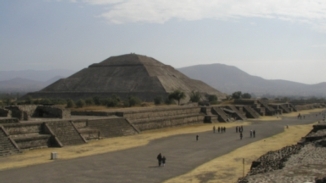
墨西哥古城曾驯养兔子
Ancient Mexican Metropolis Engaged in Hare-Raising Activity
墨西哥古城曾驯养兔子
Upending the belief that residents of ancient Central America did not practice animal husbandry, new evidence shows that people in Teotihuacán raised and bred rabbits and hares.
新证据显示,特奥蒂瓦坎的原始居民曾经饲养并繁殖野兔,这颠覆了古代中美洲没有畜牧业的传统观念。
播音/撰文:辛西娅·格雷伯(Cynthia Graber)
翻译:杨枭
审校:吴非
As humans developed civilizations in Eurasia and Northern Africa, they also domesticated animals for food and labor: horses, cows, goats, pigs, sheep and a few others. But no evidence existed for the deliberate cultivation and breeding of animals in North or Central America—until now.
当人类在亚欧大陆以及非洲北部发展文明时,他们也开始驯化动物作为食物和劳动力,比如马、牛、羊、猪等等。但直到最近,才有证据显示中北美地区的古人类也会有意驯养、繁殖牲畜。
“So at this ancient city of Teotihuacan in particular, which is really one of the earliest urban cities in North America…”
“特别是在古城特奥蒂瓦坎,它是北美洲最古老的城市之一……”
Andrew Somerville of the University of California San Diego, talking about the metropolis that once existed some 30 miles northeast of present-day Mexico City.
加利福尼亚大学圣地亚哥分校的安德鲁·萨默维尔谈起了这座曾经的大都市,它位于今天的墨西哥城东北部30英里(约48千米)的地方。
“…previous excavations have found a lot of rabbits. But at one compound in particular they found more evidence that they were interacting with rabbits more intensively. There was a statue of a rabbit. There was evidence that maybe they were butchering them. And this compound, which is called Oztoyahualco, actually had almost twice as many rabbit bones relative to the other complexes at the city. So it did seem like something was different with this particular compound.”
“在之前的挖掘工作中,人们发现了许多兔子。但在Oztoyahualco挖掘现场,更多的证据表明,当地居民与兔子的关系比之前认为的更紧密。那里还有一座兔子雕像。还有证据显示,当地人当时或许正在屠杀兔子。这里的兔子骨骼数量近乎是在其他建筑群中发现的两倍。由此可见,这个挖掘场地似乎的确很不同。”
Somerville and colleagues tested 134 rabbit bones at the 2,000-year-old site, as well as 13 contemporary samples. If the ancient rabbits fed on wild vegetation, the carbon isotopes in the bones would show evidence of what’s known as the C3 photosynthetic pathway. But the domesticated crops of that time, such as corn and cactus fruit, employ what’s called the C4 pathway—which leaves a different carbon isotope ratio in the bones.
萨默维尔和同事检测了这处拥有2000年历史的遗址中的134根兔子骨骼,以及13根来自其他地区的同时代兔子骨骼。若是古代兔子以野生植株为食,那骨骼中的碳同位素会表现出C3的光合途径。但那个时期的玉米、仙人掌果等农作物,利用的是C4光合途径,这就导致了骨骼中的碳同位素所有不同。
“Fortunately we were able to actually show that rabbits from this compound did actually have higher carbon values, significantly higher carbon values. Which means that they did have significantly different diets from other rabbits within the city, and also significantly different diets than wild rabbits from around the region. Which is pretty strong evidence we say to show that they were actually being provisioned by humans, fed by humans, managed by humans.”
“幸运的是,我们足以证明这个挖掘现场的兔子体内有更高的碳同位素值,明显区别于这座城市内其他地方的兔子和周边地区的野兔。这非常有力地说明,这些兔子是被人类饲养管理的。”
The research is in the journal PLoS ONE. [Andrew D. Somerville et al,Animal Management at the Ancient Metropolis of Teotihuacan, Mexico: Stable Isotope Analysis of Leporid (Cottontail and Jackrabbit) Bone Mineral]
这项研究发表在PLoS ONE期刊上。
It’s true that the carbon evidence could also be the result of the rabbits being trapped in corn fields, where they were scavenging. But the presence of the dedicated pen and the statue of a rabbit led the scientists to conclude that the animals were in fact being raised—which changes our understanding of New World cities.
当然,碳同位素也可能说明当时的兔子被困在了寻觅食物的玉米地中。然而,专用笔和兔子雕像的出现让科学家坚信,这些动物实际是被饲养的。这改变了我们之前对于新大陆城市的看法。
“That is one of these assumptions about the new world—that they just didn't have as intensive relationships with animals. That husbandry, especially with mammals, wasn't as important of a factor in their organization and supporting these big cities. So what we're showing is that maybe they were just as intensive in some respects as these old world cities but they’re just less archaeologically visible. A rabbit leaves a much smaller footprint than a cow or a horse does.”
“对于新大陆的认知假想中,其中之一便是认为他们与动物的关系不是很密切。在他们的社会结构与对大城市的支持中,畜牧业(尤其是哺乳动物的畜牧业)并不是重要的一环。而我们的证据表明,其实他们在某些方面可能像这些旧大陆的城市一样,与动物密切相关,只是在考古学上难以发现。毕竟兔子的脚印要比奶牛或是马儿的小得多。”
未经书面许可任何人不得复制或镜像
京ICP备11000850号-1
 京公网安备11010502039775号
京公网安备11010502039775号 信息网络传播视听节目许可证0111611号
国家科技基础条件平台

















